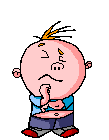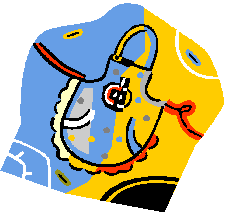 Decision Making
Decision Making
 Decision Making
Decision Making
Making decisions can be very difficult for young children (and adults too!). The study of economics focuses on the problem of scarcity--a problem that requires making decisions. To be wise consumers, producers, workers, and parents, we need to learn to make wise decisions--using economic decision-making skills.
"Although it is not a definition, a good means to describe economics is as a way of thinking. It provides a means to make sense out of complex choices. The choices are necessary because of the limited resources available to satisfy our wants. This is scarcity, and in its essence, this is what economics is all about.
Decisions may be personal, such as whether to buy a new television set or take a vacation.
Decisions can be social, in that the consequences of the economic decision can affect informal groups of two or more persons or entire nations at the present time and for many future generations, such as the environmental impact of an economic decision. In a democracy, groups often participate in the decision-making process. If it is an economic decision about the location of a road, a school, or the use of a land area, etc., individuals usually participate in the decision-making process as members of groups or by having the opportunity to elect individuals who will represent them.
What is the nature of this decision-making process, this economic way of thinking? First, it should be pointed out that there are at least three ways of making economic decisions.
One is impulsive
. In this situation, almost no thoughtful consideration is given. When a consumer plans and carries out a shopping trip to buy a shirt that is on sale but suddenly decides to purchase a hat, an economic decision has been made, although it is an impulsive decision.A second type of economic decision that requires little or no thought is a habitual decision. The consumer who buys gasoline from the same retailer week after week gives almost no thought to the decision-making process, and in fact, is probably thinking about something else while purchasing the gasoline.
For me, these are not illustrations of an economic way of thinking. Before considering the steps of the process of an economic way of thinking, Iíll mention some of the characteristics of the third way of making economic decisions, an economic way of thinking.
1. Communication about the problem or decision to be made should be clear to all those involved. Consider how often there is class discussion about an issue and then half-way through the decision it becomes obvious that many do not really understand the problem or issue or agree about what it is.
2. Economic decision-making requires logical thinking. This means that common fallacies should be avoided. For example, if one thing follows another, it does not necessarily mean that the first caused the second.
3. It cannot be assumed that because events have happened in a particular sequence in the past, they will occur in the same sequence in the future.
4. Another fallacy is the error of wishful thinking. An investor cannot wish the price of stocks to new, record highs. In fact, economic reasoning requires a certain amount of detachment or objective analysis.
5. Economic thinking and the process of making decisions always involve anticipation of the consequences of the alternatives that are considered. By thoughtfully considering the consequences of each alternative, all but one alternative is rejected and the choice is made based on the preferred anticipated consequences.
The third type of economic decision-making truly is an economic way of thinking. This is what economics is all about. We cannot have everything we want because our resources are limited. As a result of this problem, we are forced to make choices. After considering the alternatives, we choose based upon the anticipated consequences. Stated more formally as distinct steps, we:
1. Identify the problem. This includes defining what we want and identifying the alternatives that move us to trying to satisfy our wants.
2. Analyze each alternative. We evaluate each alternative by considering the pros and cons of each, or as the economist might say, "after considering the benefits and costs of each."
3. Make a choice. In this last step we choose the preferred alternative, rejecting the others. Economists explain that the next best alternative is an opportunity cost.
Strategies for Teaching Economic Decision Making
Strategy 1
- At the
primary level, one curriculum (Personal Finance: Pocketwise, by National
Council on Economic Education) for incorporating economic decision-making involves
children in using an apron with three pockets on each side of
the front to consider several economic problems. To illustrate, assume a child
is trying to decide which of two pets, a hamster or a goldfish, would be the
best choice. The child has four, 4" x 6" cards. Using two cards for each of the
two alternative pets, the child indicates what is good and bad about each pet
(benefits and costs). This can be done by drawing, using a few words, or writing
complete sentences depending on the age and maturity of the child. The cards are
next placed in one of the four respective pockets on the front of the apron. For
each alternative pet, one pocket is for the card that indicates what is good
about the pet and the other card is placed in the pocket representing what is
bad about the pet. After this analysis, the child selects the best pet.
Economic Education) for incorporating economic decision-making involves
children in using an apron with three pockets on each side of
the front to consider several economic problems. To illustrate, assume a child
is trying to decide which of two pets, a hamster or a goldfish, would be the
best choice. The child has four, 4" x 6" cards. Using two cards for each of the
two alternative pets, the child indicates what is good and bad about each pet
(benefits and costs). This can be done by drawing, using a few words, or writing
complete sentences depending on the age and maturity of the child. The cards are
next placed in one of the four respective pockets on the front of the apron. For
each alternative pet, one pocket is for the card that indicates what is good
about the pet and the other card is placed in the pocket representing what is
bad about the pet. After this analysis, the child selects the best pet.
Strategy 2 - Older children can use the same procedure with a decision-making grid shown in Figure One below.
Figure One. Decision-Making Grid.
|
Can be used again |
Takes time to recycle |
Makes community |
|
| Alternative 1 - Recycle |
+ |
- |
+ |
| Alternative 2 - Don't Recycle |
- |
+ |
- |
For this illustration, consider the issue of whether to recycle some consumer product. The first step is to identify criteria that are important in the decision-making process such as "Can Be Used Again," "Takes Time To Recycle," or "Makes Community More Attractive." Next, place a plus (+) or minus (-) sign in each cell as shown in Figure One. Then, total the pluses and minuses. The alternative that has the largest number of pluses can become the childís choice.
Strategy 3
- A
third strategy is to simply list the benefits and costs of each alternative.
This procedure is used by consumers and producers alike. A consumer might use
this procedure to decide between buying a new television or taking a vacation. A
producer may use the same procedure to decide whether to hire another worker or
buy a new delivery truck. Think of the possible benefits and costs that should
be considered in these two illustrations."
Applying Economic Reasoning to Environmental Decisions, Dr. Jack Morgan,
University of Louisville
| Alternative: Buy a TV | |
| BENEFITS | COSTS |
| Alternative: Take A Vacation | |
| BENEFITS | COSTS |
Problem solving may be used to teach your child sound thinking skills and problem solving-processes. It may be used to help teach children how to work in groups, how to share information, how to compromise and collaborate and how to articulate a position.